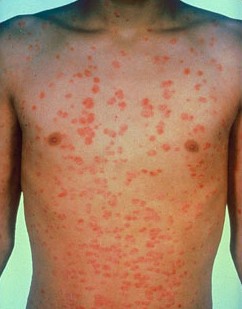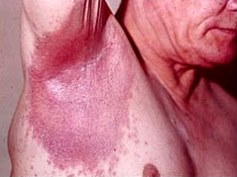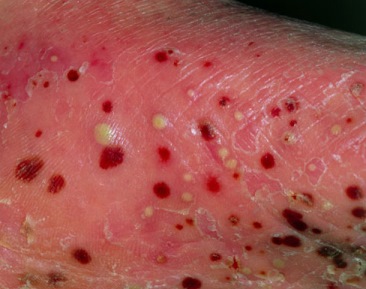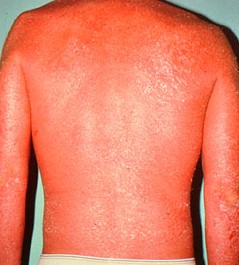There are five different psoriasis types, all of which involve abnormal skin cell growth. Symptoms vary a bit depending on the type, though, and some types are more serious than others. People usually have only one type of psoriasis at a time, with the exception of erythrodermic psoriasis, a rare but life-threatening form of the disorder that usually occurs in people that also have plaque psoriasis.
Five Types of Psoriasis
The symptoms of different psoriasis types vary somewhat and it’s important to know what type you have because some types are more serious than others and the treatment may vary depending on the type of psoriasis, as well. See your doctor or a dermatologist if you have questions about what type of psoriasis you have.

Plaque Psoriasis – This is the most common type of psoriasis. Plaques are red patches with clearly defined edged, covered with silvery scales. They usually itch and may be painful. Most often, they appear on the elbows, knees, lower back, and scalp.

Guttate Psoriasis – This is the second most common type of psoriasis, which affects about 10 percent of people with the condition. Instead of large plaques, people with guttate psoriasis have small red spots on the skin. Most often, they appear on the torso and limbs, though they may also appear on other areas, like the face or scalp. Guttate psoriasis often develops in childhood, usually after an infection like strep throat, tonsillitis, or an upper respiratory infection.

Inverse Psoriasis – Also known as intertriginous psoriasis, this form of psoriasis is sometimes found in people that also have other forms of the condition, like plaque psoriasis or guttate psoriasis. Instead of scaly plaques, it causes smooth shiny red areas under folds of skin, like in the armpits, in the groin area, and under the breasts. The reason it’s not scaly is probably because of all the moisture in the skin folds. Inverse psoriasis is most common in obese people.

Pustular Psoriasis – As the name suggests, pustular psoriasis causes pustules, or blisters filled with pus, to form on the skin. The pus consists of white blood cells and is not infectious or contagious. Pustules usually develop on the hands and feet, though they can occur elsewhere. The condition is painful. It usually occurs in adults and is often triggered by illness, pregnancy, or emotional stress.

Erythrodermic Psoriasis – Unlike other forms of psoriasis, this form of the condition usually appears on people that have another form of psoriasis, most often plaque psoriasis. It’s very rare and is the most serious of all psoriasis types. Skin looks as if it has been burned and peels or flakes off. It’s very itchy and extremely painful. It’s usually accompanied by a rapid heartbeat and by unstable body temperature. According to the National Psoriasis Foundation, heart failure can occur, so if you think you are experiencing erythrodermic psoriasis, see a doctor right away.
Treating The Different Psoriasis Types
Topical treatments are usually the first line of defense for most psoriasis types. People with guttate psoriasis sometimes find it difficult to apply topical medications, though, since they often have literally hundreds of tiny red spots to which it must be applied, so oral medications are sometimes prescribed instead. Oral or injected medication may also be needed for severe cases of psoriasis, especially pustular or erythrodermic psoriasis.
Over-The-Counter Medications
There are some over-the-counter topical medications for psoriasis. Our favorite is Terrasil Psoriasis Therapy Max, which contains salicylic acid to reduce the redness and inflammation caused by psoriasis, along with peppermint oil to remove itching and discomfort and other ingredients selected to relieve symptoms and help skin heal. It can be used to treat all forms of psoriasis. To learn more, just follow the link to the company website.
National Psoriasis Foundation: Erythrodermic Psoriasis
